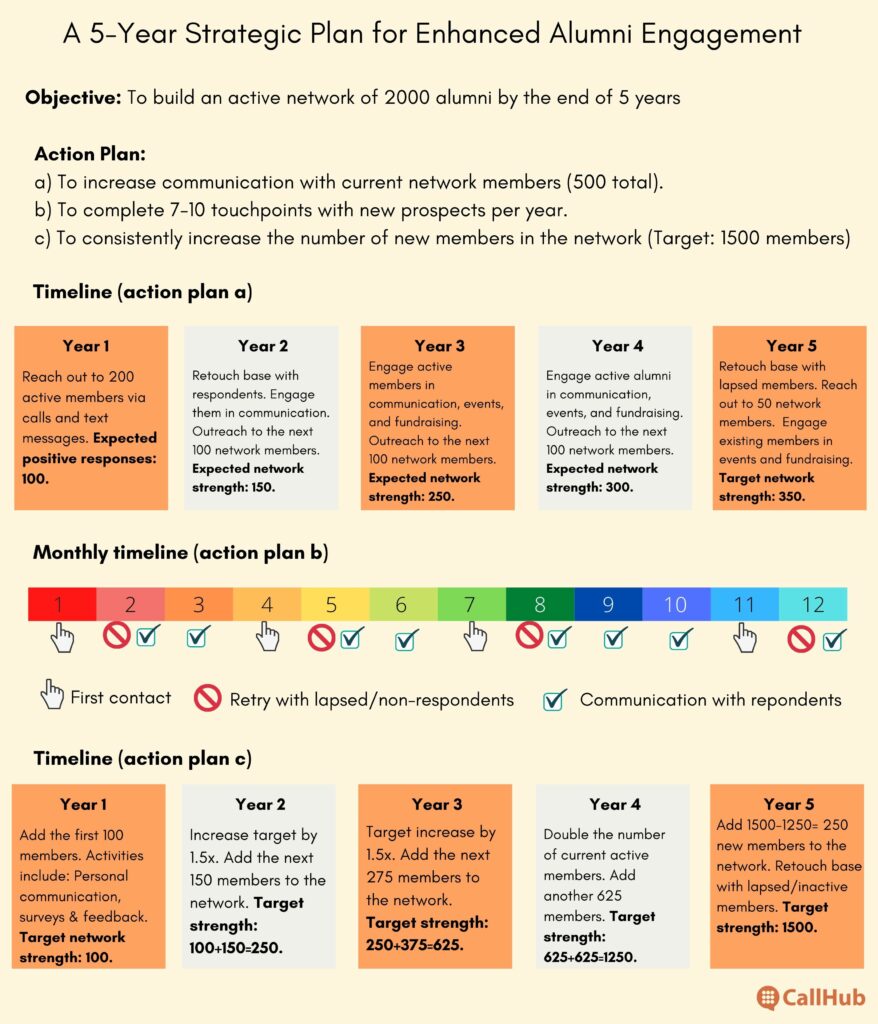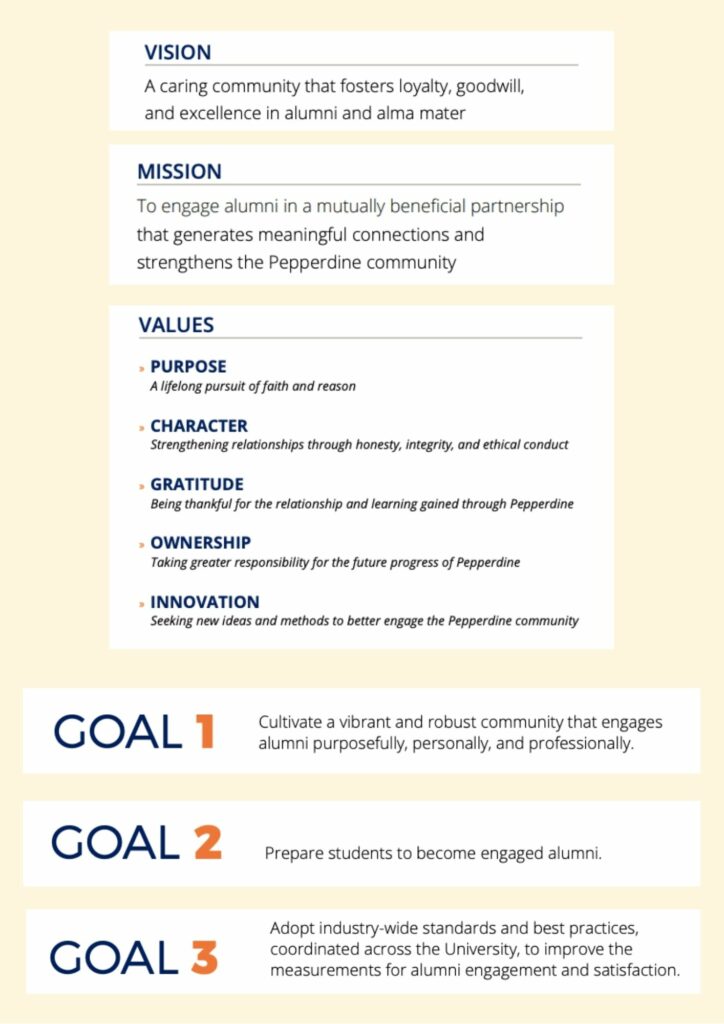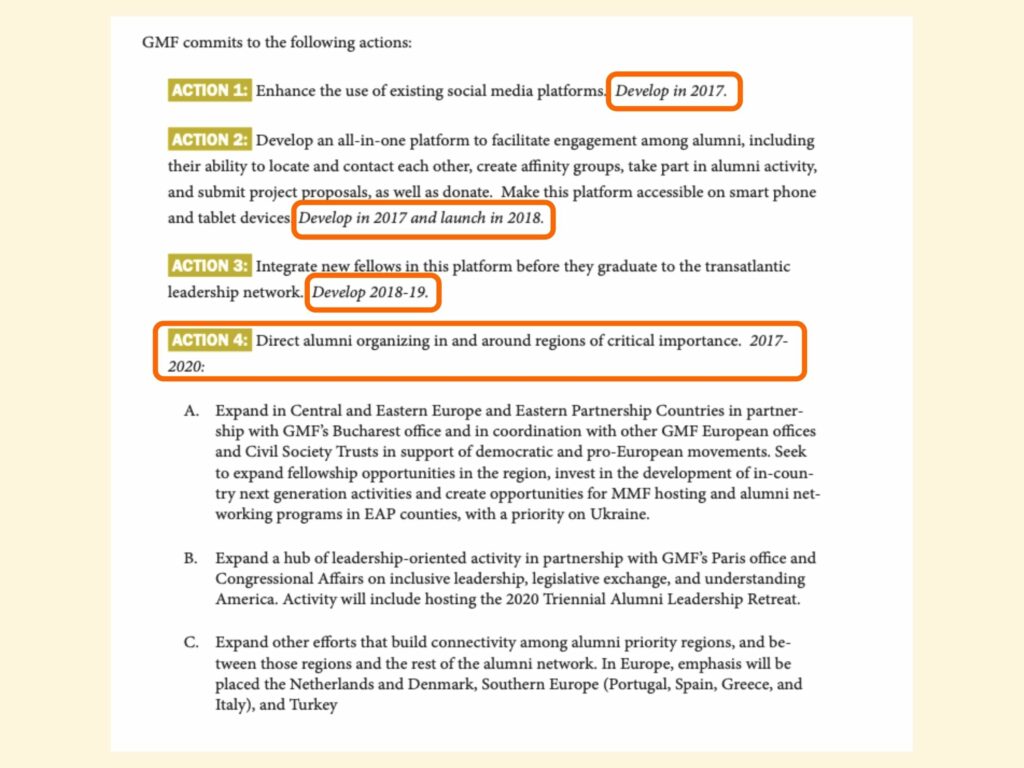Table of Contents
For many esteemed universities, an alumni relations strategic plan is a non-negotiable part of maintaining contact with students after they pass out. The plan considers not just a way of keeping in touch with the alumni but also setting tangible goals that
- Strengthen the university community locally and globally.
- Facilitate two-way communication between the university and alumni for increased engagement.
- Recognize the experiences, needs, and prospects of alumni to improve university standards continually.
- Promote a culture of philanthropy among the alumni to support the university.
If you are struggling with maintaining strong alumni relations, this post will help you draft an alumni relations strategic plan that fulfills your objectives.
What is a 5-year alumni relations strategic plan?
Universities and colleges often script a 5-year alumni engagement strategic plan to initiate and enhance alumni engagement. By definition, this long-term plan is a description of
- Where your institution stands at the moment in terms of alumni relations.
- What you plan to improve in that aspect in the next five years.
- How you plan to achieve these goals and objectives.
The five-year term allows the alumni relations department to
- Divide the ultimate goal into several short-term objectives in the alumni engagement strategic plan.
- Script an action plan with activities catering to specific objectives.
- Follow a timeline that accommodates setbacks and reinvents itself to catch-up with the targets.
Take the following plan, for example:

Here, in order to achieve the target of 2000 alumni members, three strategies are used:
- Outreach to existing members and revitalizing their membership.
- Completing 7-10 touchpoints to each contact in the list (the average number of touchpoints required to get a response).
- Outreach to 1500 new members over the period of five years.
These activities run simultaneously and leave scope for improvement (e.g, if there’s less success in renewing membership of current members, the team can reach out to more new members instead).
How do you structure an alumni engagement strategic plan?
For an alumni relations department at a college or a university, a typical 5-year strategic plan includes:
- Goals
- Objectives
- Action Plan
- Timeline
Let’s look at how to plan for each to create a well-structured alumni relations plan.
You can use the same template to craft a plan that is anywhere between one to five years long.
Goals
What is the overarching goal you aim to achieve? Goals are qualitative targets and define the end purpose of your plan.
An example of a goal for an alumni association strategic plan is: Creating a sustainable outreach effort that drives meaningful alumni engagement.
To finalize the goal(s) of your alumni association strategic plan, follow these steps:
- Start with scripting the vision, mission, and values of your alumni association department.
- Identify how alumni relations fit into this?
- Understand what your overarching mission is to strengthen or maintain alumni relations?
You can take inspiration from this 5-year alumni engagement strategic plan of Pepperdine University in California (2018-2022).

Common goals for an alumni engagement plan include:
- To identify and cultivate partnerships with alumni and enhance the impact of the college alumni community globally.
- Evaluate the needs, expectations, and attitudes of various alumni groups, and segment them into appropriate groups for better engagement.
- To identify engagement opportunities beneficial for alumni as well as the university and cash in on them.
- To create a community that encourages participation, philanthropy, and engagement to further the mission, values, and prospects of the university or college.
These broad goals are further split into smaller, shorter objectives in the alumni engagement strategic plan. While your plan’s goal talks about the end result in a qualitative, subjective manner, objectives are quantitative and can be calculated or studied definitively.
Objectives
What are the specific objectives that will help you measure the success of your alumni engagement plan? Objectives are tangible and talk about particular outcomes that your action plan needs to achieve.
For example,
→ To engage the current network members in two-way communication.
→ Identifying top engaged players and leveraging their influence.
→ To reach out to 1500 new contacts in the next five years.
To set the objectives for your alumni relations strategic plan,
- Jot down specific short-term targets that correlate with and work towards your main goal.
- Note the desired outcomes of each of these targets. These are your objectives.
- Divide the objectives by team, skillset, deadlines, and chronology (what objectives must be prioritized to allow the next set to operate).
For instance, if your main goal is to create a sustainable outreach effort that drives meaningful alumni engagement, your objectives can be:
- Developing a strategic approach to engage x number of current alumni in a dialogue. You engage in studiable conversations that help you understand:
- Their preferred mode of communication.
- What do they expect from the alumni network?
- What keeps them in the network, and what will be a deal-breaker?
- How are they willing to support the university? (e.g., donations, spreading the word, mentorship etc.)
2. To create an outreach effort that learns from these findings and helps with future networking.
3. Identifying x top engaged players and leveraging their influence for outreach.
For automated, personalized communication at scale, check out CallHub’s tools tailored for higher education institution needs: Calling And Text Marketing For College And Universities.
Here’s an example of objectives set by Tulane University in New Orleans for their 3-year alumni relationship plan:

Your objectives simplify your cadence and set the foundation for what activities you will undertake to achieve the overarching goal. Once you finalize the objectives and sub-objectives, the next course of action is to strategize an action plan.
Read Also: 6 Alumni Fundraising Best Practices and Top 15 Ideas for Your Next Campaign
Alumni Relations Strategic Plan: ACTION!
How do you plan to meet the objectives of your alumni relations strategic plan? Your action plan should cover all the day-to-day activities and tactical ideas that the team will undertake.
A typical alumni relations strategic plan covers the following points:
- Communication: What do your members prefer? Start with asking the existing members how they would like to communicate with the university and then use a multi-channel approach for outreach. Your action plan regarding communication must include who you reach out to, when, and how.
A 2018 study about communication preferences pertaining to loyalty programs (similar to an alumni network) discovered that
– 42% of respondents prefer communication via emails.
– 32% prefer marketing via text messages.
– 15% said mobile apps.
Taking inspiration from these numbers, you can start with sending out emails and texts to ask for their preferences and then move on to specific channels that they prefer.
Related Reading: Contacting Alumni Email Sample and Tips To Enhance Your Interactions
- Incentives: How do alumni benefit from being a part of your network? Setting and conveying the incentives that come with being a part of your esteemed alumni network can increase positive responses and sustained engagement. Examples include: access to campus facilities, event passes, career opportunities.
- Events: An alumni event can be a reunion, fundraiser, seminars that benefit current students, career events, etc.
These events are high-investment, high-reward nature, and reflect high engagement levels among participants and respondents (individuals who RSVP, even if they can’t attend). Keeping a note of such alumni can help you with leads for future communications, donation appeals, and peer-to-peer networking. This perfectly fits into your overall alumni engagement strategic plan.
Related Reading: Alumni Engagement Metrics: Why Responses Are a Better Success Measure Than Participation
- Marketing: An alumni relations action plan is incomplete without a strong marketing campaign. Marketing includes:
– Social media ads that target your online followers.
– Sending emails and text messages as the first touchpoint to your lists.
– Following up with individuals who have shown interest.
– Personal communication with highly engaged individuals.
For details on how to strategize your marketing campaign, read A Quick Guide To Essential Nonprofit Marketing Strategies
- Appeals: Whether you are making a low-engagement appeal (e.g., following on Facebook) or high-demand requests (e.g., donating), three things are absolutely essential:
- An effective call to action.
- The CTA framed in the right manner.
- Appropriate timing for the appeal.
Adding ‘appeals’ as part of your action plan will give you adequate time to intelligently and effectively strategize them.
- Tracking and Analysis: A one, three, or five-year plan cannot succeed without constant monitoring of progress, success points, and improvement opportunities. Use software and human resources to continually check:
- How far along each activity has come in achieving its targets.
- If you need to evolve or dissolve strategies.
- When one action concludes successfully, how and when you transfer to the next.
For more on how to effectively set your action plan, read Alumni Engagement Strategy & Best Practices: 9 Top Ways to Nurture Your Network.
Alumni relations strategic plan: The timeline
When should each action take place, and what deadlines should your objectives follow? A set timeline will help you divide your action plan into segments and make the end goal more manageable.
Once you have allotted specific tasks to team members, you need to pencil down a timeline for them to follow. A 5-year alumni engagement strategic plan gives you ample time to divide the months and dedicate them to specific objectives.
Draw a timeline considering:
- Months that have historically been successful for alumni outreach.
- The average time your alumni take to respond from the first point of contact.
- An average number of touchpoints it takes you to get results from an alum.
- Start and end of the academic year.
- What activities can go parallelly, what actions can overlap, and what activities need to see success before moving to the subsequent ones?
Consider the German Marshall Fund Of The United States’s alumni engagement plan for 2017-2020:

Once you set up a timeline for all action points, your alumni relations strategic plan is complete on paper. Now you only have to build a list of prospects and put your plan into action. One best practice that improves engagement and makes alumni outreach more effective is personalization.
For personalizing communication, marketing campaigns, and appeals, you need to start building a good contact list with a lot of data on your alumni. If you are unsure how to start, here’s our guide to help you weed out old and inefficient techniques and replace them with methods that work phenomenally: List Building– New Inbound Marketing Channels You Cannot Ignore!
Feature Image Source: Nick Morrison/Unsplash.

